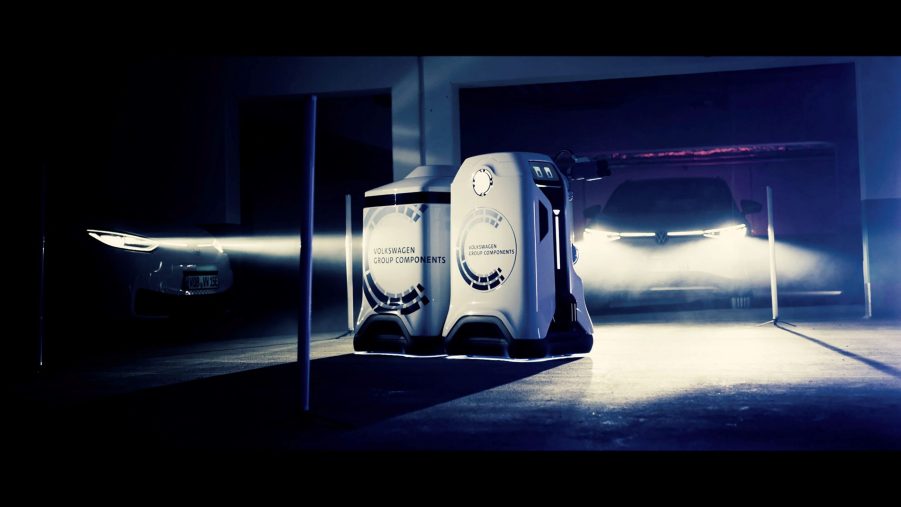
Volkswagen’s Fix for Limited EV Chargers: Send in the Droids
Though battery technology is inching towards affordability, major EV adoption still has hurdles to overcome. And as Consumer Reports’ recent survey showcases, one of the biggest is public EV charger availability. Even though fast-charging stations cut recharge time, it only works if everyday consumers can reasonably access them. And Volkswagen recently announced what it claims is a potential solution: a charging droid.
Volkswagen’s new robot is a mobile EV charger

Technically, Volkswagen calls this ambulatory charger a ‘Mobile Charging Robot,’ The Drive reports. However, given its animated LCD eyes, it’s easy to see why so many publications reference Star Wars in discussing the MCR. Though personally, I’m more reminded of the autonomous charging stations in the eX-Driver anime, as Jalopnik describes. And in a way, these comparisons aren’t too far off.
The Volkswagen MCR is meant to be a summon-able EV charger, Autoblog explains. When someone pulls into a garage or other structure with an MCR, they signal the robot via a smartphone app. The MCR then travels to the EV towing a small trailer of stacked battery packs. Once it gets close, it identifies the summoner using a vehicle-to-everything (V2X) system, Car and Driver reports.
Once it gets to its destination, the MCR extends a retractable charging arm, opens the charger port, and recharges the EV using the packs. After it’s done, the walking charging station retreats to its home location and recharges the packs. No human interaction is required, Motor1 reports.
Does it have any benefits over a standard EV charging station?
As we stated earlier, charger access is a significant hurdle for EV adoption. Admittedly, roughly 80% of EV charging occurs at home, rather than at a station, Car and Driver reports. But not every person has a home or a workplace charger. And getting one installed in an apartment complex’s garage or parking lot can be a hassle, PlugInAmerica reports.
Theoretically, that’s the issue Volkswagen’s MCR is supposed to address. It won’t replace dedicated charging stations or a home charger, The Verge explains. But it does make it easier for parking garages and similar locations to offer EV charging capabilities. Rather than set up and wire multiple individual chargers, you just need one central dock for the droid. Er, mobile charging robot.
Will Volkswagen actually build it?
As of this writing, Volkswagen hasn’t stated if it will put the MCR into full production. For now, it’s just a prototype.
However, the German automaker’s press release states that it “will…be comprehensively further developed.” And it’s worth keeping in mind that VW is planning on launching a flexible fast-charging network in early 2021.
But could the MCR turn into a real product? It’s theoretically possible. The idea of building a minimal-installation charging station isn’t new. Rivian is building some remote stations for off-roaders. So is Jeep, Roadshow reports. And it’s not as if the MCR’s overall design is bleeding-edge. As anyone who owns a Roomba can attest, self-propelled, self-guiding robots already exist.
The biggest potential stumbling blocks, besides budget, are likely to be EV charger standards and the V2X software. However, as to the former, many automakers are switching to the CCS standard, including Nissan, which formerly used the competing CHAdeMO standard, Roadshow reports. But that’s mostly in the US; in places like Japan, the CHAdeMO standard is still going strong. Plus, there’s Tesla’s proprietary plug design. Though presumably, using V2X, the MCR could perhaps switch out its plug for a different one.
That V2X software may end up being the bigger issue, The Verge reports. It’s an already-proposed idea, but one that hasn’t yet really been implemented. And it doesn’t help that the FCC recently cut V2X’s allotted frequency band for WiFi use, The Verge reports.
Still, Volkswagen’s idea seems intriguing. Plus, who wouldn’t want their own little astromech?
Follow more updates from MotorBiscuit on our Facebook page.


